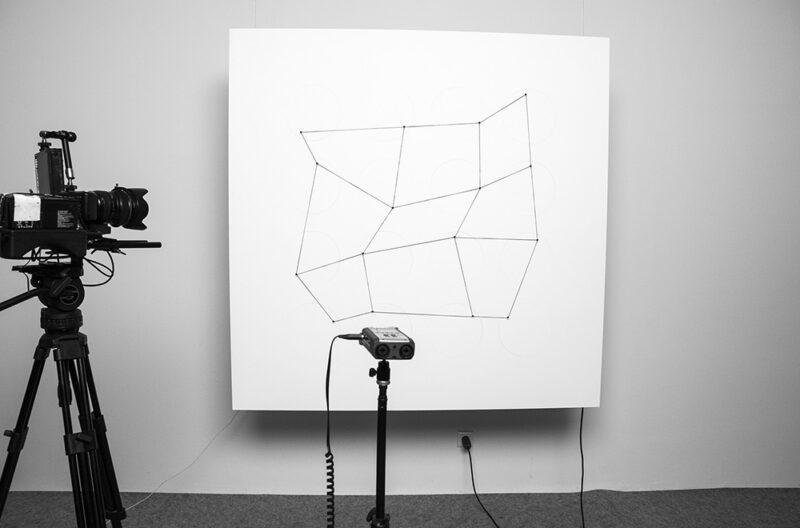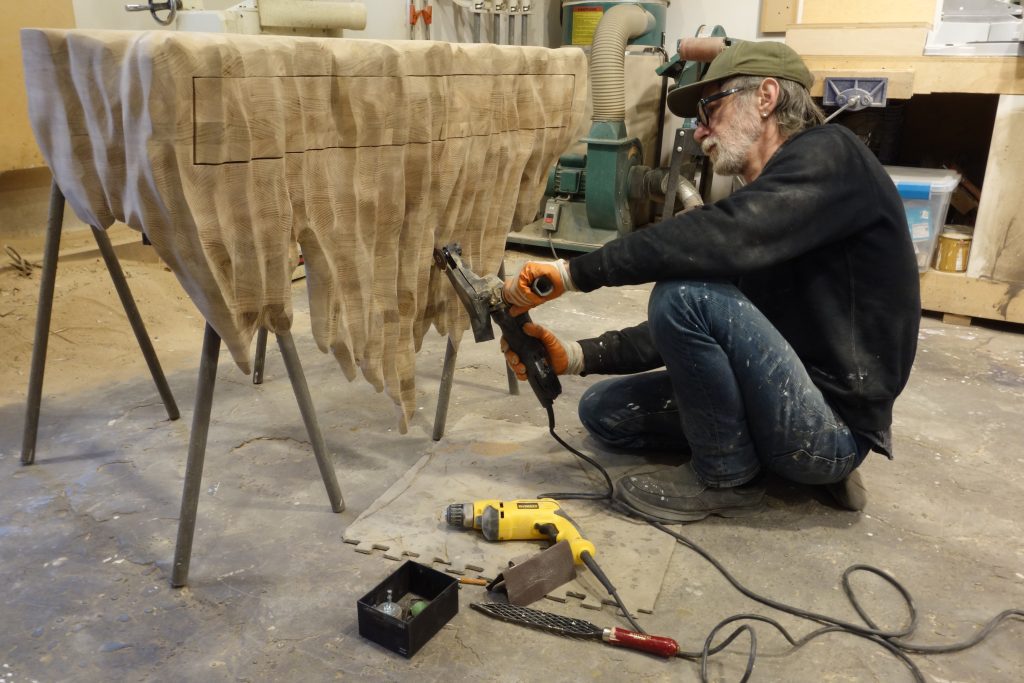

RLON: Playful Explorations of Curiosity, Science, & Metaphysics
“The motivation for our work is that glow in your eyes, that spark of curiosity. The inherent curiosity of the human mind is a great way to encourage flow states, moments of being present in the now with your full attention.”
– Philipp Eibach, Josua Putzke, & Nehemia Turban of RLON
View all of RLON’s work, including “become”.
With its experimental and collaborative artistic identity, Berlin provides an intriguing and inspirational design centre for artists and designers within the larger contemporary German design scene. A plethora of nationalities, identities, and experiences converge, giving the scene its own narrative and aesthetic – it inspires and is inspired; it encourages conversation and collaboration; and, from this, it spurs new traditions to be conceived. There is a sense of curiosity – ever present in the design studio interviewed here – which pushes the scene forward, developing practices which have both odd and unidentifiable qualities, but are also innovative and familiar. Ultimately, this crossroads of inspiration, curiosity, and collaboration make it the perfect space for contemporary collectible design to flourish.
From innovative concepts for lighting to inspired forms of art-design, Berlin-based studio RLON explores art, science, and metaphysics to create pieces which speak to human experience and the beauty of the world. Designers Philipp Eibach, Josua Putzke, and Nehemia Turban have developed a practice which merges clean, simple aesthetics with inventive forms and playful gestures. The act of turning on a light, for example, takes on a new form in their pieces “L1” and “become“: the former becomes a functional sculpture, responding to human touch along the entirety of its body, while the latter uses magnetic fields along its base and the very visual act of movement to switch on and off.
Other pieces play with the senses and notions of abstraction, as is the case in “as within ~ so without“, a wall-mounted mirror which shifts between reflective and non-reflective. Timed to a resting breathing pattern, the piece encourages the viewer to pause and self-reflect, visually portraying the sensorial and mental act of reflection. Through their exploration of science, design, and human curiosity, RLON continues to carve out their space in the Berlin design scene, evidencing that odd, peculiar, and experimental quality described by curator William Bagnol through a wide range of beautiful, fascinating, and functional pieces.
As a design studio, where does RLON draw inspiration from?
As children of a rising global consciousness, we understand design and art as ways to widen our imagination of the future and to encourage individual and confident constructions of realities – the future is less a shadow of yesterday than a reflection of now. What we think, is what we get. So, let us think sassy, brave, and juicy. Let us connect the dots not straight, but curved.
We founded RLON because we believe that there are infinite ways to unfold and experience the beauty of this world. Our inspirations come from a very personal drive to explore and understand as much as they arise out of a fascination for other beautiful minds and their imaginative landscapes.
Curiosity, human experience, and narrative all play an important role in your practice. How do these notions shape your approach to design?
Our form of expression is the creation of objects and installations that address the richness of the human senses and intellect. With the tools of design and soul of art, we playfully combine the joy of experimenting with professional craftsmanship, traditional techniques with state of the art technology.
Sometimes it’s just about little surprising situations, such as an unusual switch that turns a circumstantial activity – such as switching on and off a lamp – into a more conscious act of interaction. But, it is also about larger aha-moments, when the experience of a kinetic installation inspires you to understand and integrate a social concept, a physical phenomena, or a law of nature.
The motivation for our work is that glow in your eyes, that spark of curiosity. The inherent curiosity of the human mind is a great way to encourage flow states, moments of being present in the now with your full attention.
From a technological perspective, your work with lighting explores many different uses and possibilities. What draws you to this type of experimentation? For example, “Become”, “L1”, and “Trumpet”
Light and shadow form the spectrum in which we grasp and experience our surroundings. Colors, shapes, textures, and contours contain a whole universe of archetypal information and characteristics. It is this semantic space of intuitive understanding that enables us to play with metaphors and double meanings in an almost poetic way.
We are drawn to the freedom to work with sculptural references on the same level as we work on the perfection of technical details. From rough sketches to refined design solutions, physical and analog experiments are part of every step of the process.
TRUMPET is one of many luminaires that we built with our lighting system SYNTAX. This system in particular is based on the experimental approach. By offering a toolbox with countless options and variations, we wanted to give ourselves and other designers the opportunity to design with tube-bulbs quick, easy, and freely in space. The light artist in us loves S14 tube bulbs, since the geometry is very unique and the bulb by itself is a sculpture. They have been around for a while, but the only way to install them was a fixed wall mounting. The SYNTAX system allows it to speak a new language of light with this illuminant – being suspended on a cable, fixed to a pipe, or a combination of standard lamp components.
With our luminaire L1 on the other hand, we wanted to reduce a lamp to the minimum. No stand, no power supply on the cable and not even a switch – instead, L1 can be turned on and off with a single touch on any part of its surface. L1 is an invitation to the user to play with light and shadow, depending on how and where the luminaire is positioned in the room.
BECOME arose from experimentation with the energy of invisible magnetic fields. As a metaphor, it brings to mind the invisible forces one needs to overcome on the journey to the center, the courage it takes to become someone and discover yourself. The desk lamp is controlled by moving a metal ball from one magnetic field to another. It requires a little dedication to release the ball from its origin, but, once set in motion, the mission becomes obvious. Moving the ball, exploring the unknown, is the only way to even discover the other gravitational field that leads the way to the center of the ring and fully energizes the object.
“We are drawn to the freedom to work with sculptural references on the same level as we work on the perfection of technical details. From rough sketches to refined design solutions, physical and analog experiments are part of every step of the process.”
In addition to the lighting pieces featured above, the installations “Samsara” and “Vertices” play with abstraction and evolving materiality. Can you describe your thought process behind the creation of these pieces?
With our kinetic works, we translate inspirations, emotions, experiences, principles, and values into poetic apparatuses and installations. We want to make abstract models tangible. All elements that contribute to the creation of an outcome can be recognized and deciphered. We encourage the viewer to use [their] own imagination and curiosity, which are great tools to make up your own mind about things.
SAMSARA, for example, is a mechanically animated mandala. The idea of a mandala is to transmit information in a way that transcends the use of words as a language. As a representation of a synergetic system, it is a metaphor for economical and social systems that acknowledge the importance of each participant. With SAMSARA, we wanted to provide a physical manifestation of the metaphysical concept that everything is connected. The sole energy source of the installation is a rotating disc in the center. It shows how a small impulse can change a whole system, when all the parts are connected in synergy.
In addition to the realization of our own inspirations, we also develop these devices for organizations, companies, artists, and museums. Basically for everyone who has an interesting story to tell and wants to communicate it on an emotional and intuitive level. For a current project, we [are translating] the feeling of standing by the sea and looking at the water into a poetic machine. It reproduces the glittering of the sun and its reflections without using actual water, while at the same time showing the physics of particles in waves. From the end of September, this work will be on display as the center piece of a permanent exhibition on [the island of] Usedom in the Baltic Sea.
How does RLON’s practice reflect and/or diverge from the contemporary Berlin and/or German design scene?
Berlin is an ever evolving microcosm. In a way, it doesn’t even really feel like Germany. Berlin makes up his own mind about things, that produces a strong gravitational field for new ideas.
Incredibly interesting people from everywhere pass by or come to stay. The result is a very fertile soil for all those things and thoughts that no one could ever imagine before. There is a good chance that a conversation with a random stranger can lead to the next project or a great idea. At the same time, there is a growing network of designers, applying the ideas of synergy and cooperation. We are grateful to have our small part in this evolutionary process, by sending and receiving inspiration, by collaborating with smart minds and skilled hands.
In some sense, of course, we diverge from other approaches to design. [However,] this is not so much about location, but about the many possible meanings of the term design itself.
Our main focus is not to make good looking pretty things, but rather to create objects and spaces that stimulate the senses of the viewer. In the spirit of Buckminster-Fuller, we feel design has the power to make old models redundant by offering new proposals. Thus, design always takes part in a social discourse.
Bio


Berlin-based studio RLON offers a 21st-century take on Space Age design, specializing in minimalist lighting with striking graphic and interactive elements.
RLON was established by Josua Putzke (b. 1981), Phillip Eibach (b. 1981), and Nehemia Turban (b. 1982) in Berlin in 2016. Their projects—ranging from furniture design to installations—playfully explore concepts of time, space, and probability. The three founders were sharing a studio space in 2015 and bonded over a mutual interest in metaphysics, spatial interaction, and a “sassy” sense of humor—each of which plays a role in their lighthearted and poetic work. Since they joined forces, they have been driven to create, in their words, “objects and narratives for curious spaces and curious minds.” They view their work in the context of a growing global consciousness and hope to widen the ways in which the future is imagined by “crafting interactions and narrating stories that trigger awareness and award curiosity.”




















Responses